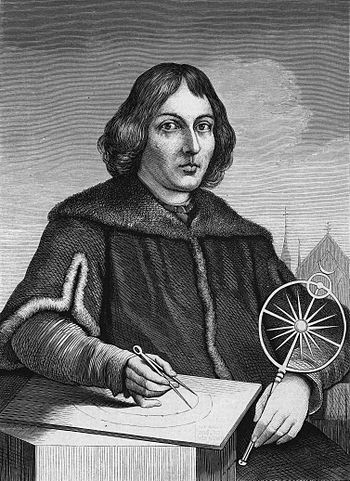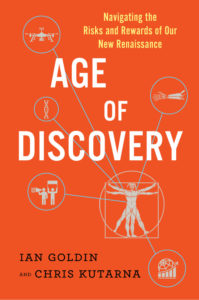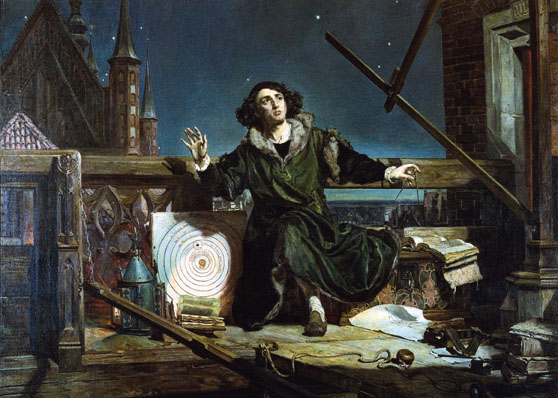by Ian Goldin and Chris Kutarna
Copernicus: The formula for flourishing genius
A flourishing of genius like that of Copernicus does not just “happen.” It arises as a result of specific social and intellectual conditions that enable creativity to shine forth. Why did genius shine so spectacularly during the Renaissance? And why is it happening now?
Part of the credit goes to the rare individuals—the geniuses—who are born into a given age. Individuality is a crucial component to every instance of genius. As Brian Arthur, today one of the world’s foremost thinkers on the topic, observes, the Aha! moment, when a new principle overturns an old, “wells always from an individual subconscious.” Often, something strange or unique in a person’s focus tips the odds of a breakthrough in their favor.

focused on finding purer-than-Ptolemy harmony in the heavens. Leonardo focused on the study of optics and engineering. Michelangelo focused on marble blocks, each of which he believed had a figure trapped inside, begging for release. And when such focus produces an Aha!, whatever follows will embody its author’s uniqueness.
But the presence of great, focused minds is not itself sufficient for genius to erupt society-wide. If it were, Western European civilization could never have caught up to, then surpassed, China between 1450 and 1550. China had a technological head start and, assuming that big-brained individuals form a constant share of the population everywhere, twice as many smart people upon whom to draw.
Europe’s leap forward during the Renaissance suggests that something else mattered: collective genius. Every person possesses a unique fragment of capability; collective genius happens when society nurtures and connects those diverse fragments. Diverse minds bent to a problem can spark original ideas and contributions that accelerate individual breakthroughs, or take those breakthroughs forward. The number of individual geniuses may be a constant share of the population everywhere, but collective genius varies widely with societal levels of learning and linking up.
“All the world is full of savants, learned teachers, large libraries; and I am of the opinion that neither in the time of Plato nor of Cicero nor of Papinian were there such facilities for study as one sees now,” wrote the French author Francois Rabelais (1483–1553) in the 1530s. The biographies of those who made the biggest breakthroughs of the last Renaissance show that their singular achievements all owed a deep debt to the tangled, rapidly developing age into which they were born, and to the collective genius that flourished under such conditions.
Read more about the incredible scientific ideas of the Renaissance influencing science fiction today

Leonardo is the most famous polymath from Tuscany that history remembers, but he was far from the only one. The early humanist Petrarch (1304–74) was Tuscan, and long before Leonardo’s birth Tuscan engineers realized that they had much to gain from dialogue with Petrarch’s students of ancient Greece and Rome. The classical world’s temples, domes and roads were still in use, 1,500 years later. What was the ancients’ secret? The ability to creatively combine past solutions with present technical problems, or to communicate those combinations in drawings, was already highly prized and spreading fast at the time and place of Leonardo’s birth. Leonardo reached a new peak in these arts, in part because he had the good fortune to grow up in a moment when the supply of knowledge about the past, and the speed with which new combinations spread, shot up.
Mainz, Gutenberg’s hometown, was a crossroads for two very different domains: wine-making and coin-minting. The former contributed many styles of grape press and the engineering craft to tinker with them; the latter, metal-working skills for making molds and experimenting to find the best alloy for casting individual letters—one that would melt easily, cast well in a mold, yet survive repeated pounding in a press. These critical crafts were deep and local, but once Gutenberg successfully combined them, the diffusion of his press was guaranteed by the more general forces we mapped in Part I (despite his own best efforts to keep the technology secret).

As for Copernicus, he did his groundbreaking work in the quiet Polish district of Varmia, a place he himself styled a very remote corner of the Earth.31 But he spent his formative years, from the age of 18 to 30, hopping from one great hub of European learning to another. In 1491 he entered the Jagiellonian University in Krakow, where for three years he studied logic, poetry, rhetoric and philosophy alongside other brainy youth from across continental Europe. There he read major scientific works of the past and present that were just becoming widely available in print: the ancient geometry of Euclid and the recent trigonometry of Regiomontanus; the classical astronomy of Ptolemy and the recent astronomical tables by Peurbach; and major Arabic scientific works in their Latin translations. (The latter may have been pivotal. A sun-centered universe had first been proposed by the Greek Aristarchus in the third century BC. Europe had forgotten Aristarchus, but Arabic scholarship had not; it’s possible Copernicus borrowed inspiration from their writings.) In 1496 he moved to Italy, and spent the next seven years networking with the continent’s leading scholars. It is thanks to this network that Copernicus changed how the world sees the heavens. His 1543 book, On the Revolutions, was banned. His intellectual heir, Galileo, was harassed by the Inquisition for holding heretical views. But when Copernicus posted his draft ideas to an increasingly connected circle of scholar-friends back in the 1510s, he set loose an idea that could not be contained.
Ian Goldin is a professor and the director of the Oxford Martin School at the University of Oxford. He was Vice President of the World Bank from 2003-2006. Formerly, he was Chief Executive and Director of the Development Bank of Southern Africa and served as an adviser to President Nelson Mandela. Twitter: @Ian_goldin
Chris Kutarna is a Sauvé Fellow and Commonwealth Scholar, and a Fellow of the Oxford Martin School at the University of Oxford. An expert on international politics and economics, he was a strategy consultant at the Boston Consulting Group, then entrepreneur, and is now involved in projects across Asia, North America and Europe. Twitter: @chriskutarna
